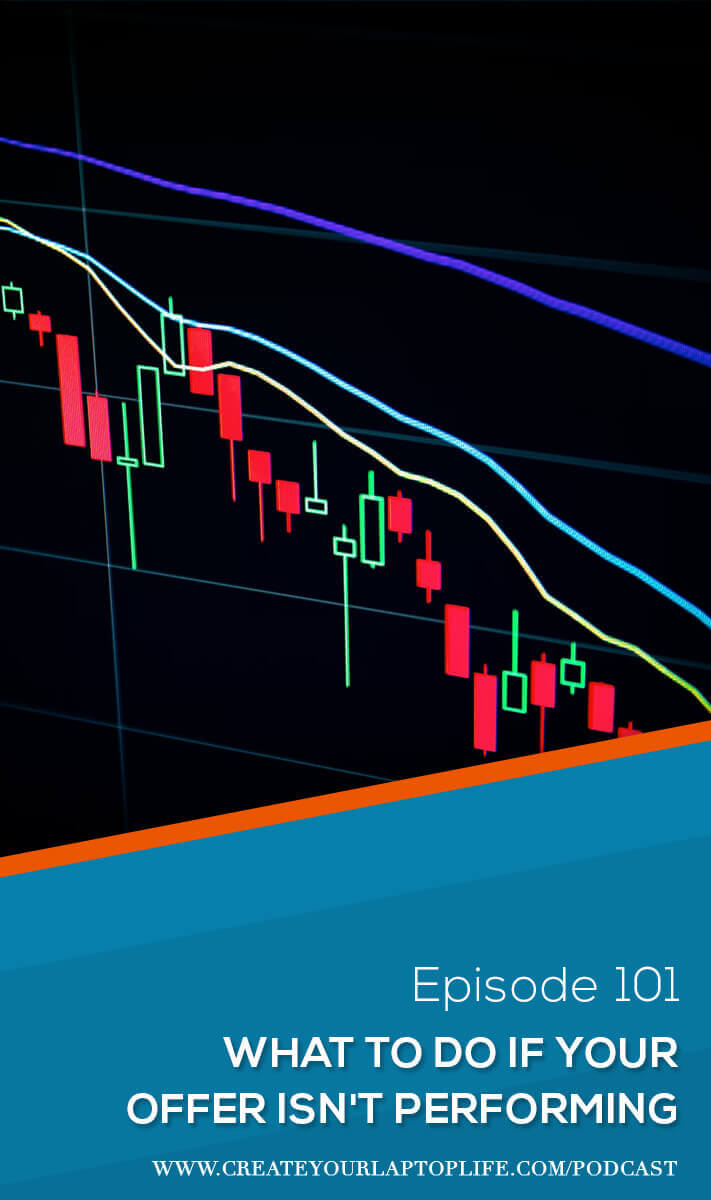Subscribe On:
Full Transcript:
Today I want to talk about what to do when an offer is underperforming. This happens all the time, we have offers that do well, and then they don’t. All of the sudden things crash. Or you may have an offer that you put out there and no matter what, just seems like it’s been a slog.
So what does it mean when we say an offer is underperforming? What we mean is that it’s not meeting your benchmark for units sold per month. And what that sentence reveals is that you have to make sure that you are in fact setting a benchmark. A lot of people don’t. They set expectations based on feelings, they set expectations based on what they see other people doing, without actually understanding what’s going on behind the scenes.
So if you’ve never set a benchmark before, that would the first thing I would recommend. And setting a benchmark can be done in multiple ways, but it’s important to know that until you have one, you can’t really claim that something is underperforming. All you can claim is that you’re having feelings about your offer, but we don’t really know what those feelings mean. You’ve attached meaning to them, but we don’t actually know.
So create a benchmark first, and there’s a couple of way that you can do this. Number one, you can do it based on how much revenue you need for that month, especially if you’re a coach or an agency and you really just have one core offer. You just decide, this is how much I need to make, so this is how many offers I need to sell. And if you have any questions about that, I don’t know if you know this, but there is a course called Future Fund that I co-created with my good friend and client, Aryeh Sheinbein, and he and I dive into understanding your core numbers for wealth building. And one of the things that we help people within their business is really kind of backing into that number. So that stops you right there, I would definitely say go get Future Fund.
Okay, a second way that you create a benchmark is based on the support infrastructure for the offer. You know, if you’re a web designer and you can only handle 10 clients a month, you can’t really set a benchmark past that. So you use sort of the infrastructure of what you business can handle and set a benchmark that way.
A third way to do it based on funnel stats, especially previous ones. So if you don’t have previous ones, you can use standardized benchmarks, in fact our course Funnel RX gives you those standardized benchmarks. But if you know, “Hey normally I convert at whatever, 2% and I seem to be able to drive 500 people a month through my organic marketing efforts”, now that’s your benchmark, and that’s what you’re measuring up against. Set a benchmark even if it’s not perfect, and there’s also room for setting a few benchmarks, right. A minimum benchmark and an ideal benchmark, and a stretch benchmark. Now you have something with which to measure, okay, now I can tell if things are underperforming.
So if you set a benchmark for 30 units sold, and you only have 12, you would take 12 and divide it by 30 and you are only at 40% of your goal. Here’s my advice on underperformance. If you are significantly 50% or less, then I would categorize that as an underperforming offer. If you are hanging around 50-70%, you may want to ask yourself, “Is this really an underperforming offer, or was my benchmark off, or was my marketing plan completely not matching my benchmark?” You know, people who say, “I have a thousand dollars to spend on ads, but I want to sell 40 units.” Well, it sounds like you didn’t create a benchmark that’s accurate for your marketing plan, or you didn’t create a marketing plan that’s accurate for your benchmark.
If you’re consistently 70-90%, you might want to continue tracking to see if, you know, you’re just seeing the bumps in your marketing, or was it a bad month, did something change? And if you are within 90% of your benchmark, I would consider you technically nearing benchmark. And I would not consider that an underperforming offer.
So once you’ve done all that, and you are consistently under 50%, now you can say, “Alright, this offer is not performing well. What do I do?” And this works very similar to a tributary where a log is blocking the water. You have to stop at the top, because if you fix the top the water flows all the way down. And if you’re busy trying to remove a log from the bottom of the river when there’s a log blocked at the top, it’s useless. So don’t start at the bottom of your river, start at the top. Remove that block first, and if that changes everything then you don’t have to go downstream.
So there are four possible logs in the way of your stream. The first and the one that’s highest up is traffic, then audience, then funnel, then offer. So if you are not generating enough traffic and visitors to even get the amount of people on the page that you need, that’s what we would consider the log up at the top of the river. You first have to remove that log and get enough traffic before you can really make a full conclusion as to whether or not the offer is underperforming.
But assuming there’s not log up there at the top of the river, and the water is flowing down, the next log you want to look at is audience. Are you actually targeting the right people? Are your audiences correct? Are you on the right forums? Are you in the right Facebook groups? Because if they’re not the right fit, or you’re targeting an audience who’s not really ready for the offer that you have, that might be why the traffic is not converting, because of the audience, not because of the offer.
Assuming of course, you’ve got the right audience and the right traffic, the next log downstream is the funnel. And that’s looking at the funnel to see what objections, what friction is happening on the page. Is it the sales page? Is it the order form? Is it the copy? Is it the design? Is it the load time? What is happening on the page? Is it the marketing argument? Etc, etc.
And assuming that that funnel has converted before, so if you have good traffic, you have the right audience, and you know that in the past it’s converted at 3%, then the next thing to ask yourself is, ‘If this is not the problem, maybe I should go back and check my traffic source and my audience again.” Because you know it’s converted before. Otherwise you’re just going to go downstream and you’re going to finally go to the offer. And you’re going to say, “Hmm, is the problem solved urgent enough? Is the price right? Is it compelling enough to get the sale? Is the offer truly the problem?”
So you can make the judgment that the offer is the problem, if you enough traffic, the right audience, and you have a decently designed and copy written funnel, and it still doesn’t perform, then you would say, “Okay, this is truly an underperforming offer.”
I hope you guys enjoyed that, thanks so much. Leave a review, share the podcast, and I will talk to you soon. Bye.









0 Comments